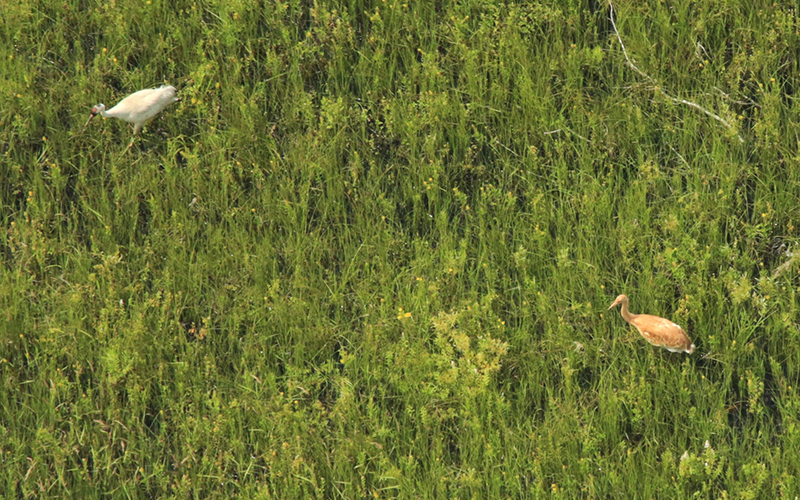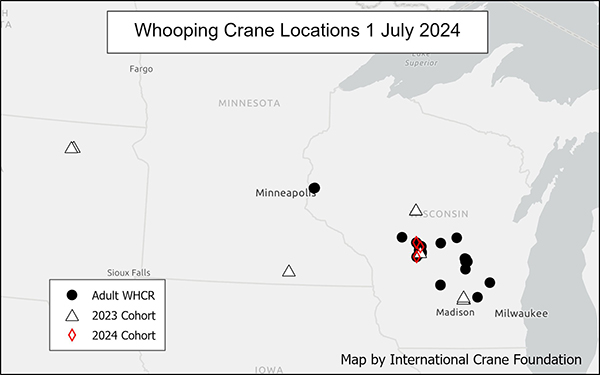
Below is the most recent update for the Eastern Migratory Population of Whooping Cranes. During June, chicks have been getting bigger! A huge thank you to the staff of the Fish and Wildlife Service, the Departments of Natural Resources of flyway states, the International Crane Foundation, and all the volunteers who help us keep track of the cranes throughout the year. We appreciate your contribution to the recovery of the Whooping Crane Eastern Migratory Population. This report was produced by the International Crane Foundation.
Population Estimate
The current estimated population size is 69 (39 F, 28 M, 2 U). Fifteen of these 69 individuals are wild-hatched, and the rest are captive-reared. To the best of our knowledge, as of 1 July, there are about 61 in Wisconsin, one in Minnesota, and two in South Dakota. The remaining birds’ locations have not been confirmed in the last month. Their last known locations (in the past month) are on the map below.

2023 Cohort
W9-23 (F) has been seen at Necedah National Wildlife Refuge in Juneau County, Wisconsin.
W12-23 (M) is still at the National Wildlife Refuge in Juneau County, Wisconsin.
15-23 (F) and W13-23 (U) are continuing to travel west from Swift County, Minnesota to Brown County, South Dakota.
21-23 (M) and 22-23 (F) traveled from Necedah National Wildlife Refuge in Juneau County back to Marathon County, Wisconsin.
19-23 (M), 17-23 (F), 20-23 (F), and 23-23 (M) are still in Columbia County, Wisconsin, together.
16-23 (F) is currently still in Freeborn County, Minnesota.
Reproduction
There were 17 pairs and 22 nests (17 first nests, five renests). Five nests hatched and produced at least seven chicks, three of which are still alive. There are currently no active nests.
Nests that were completed by 1 July:
- Juneau County: One was abandoned due to black flies; one was abandoned for unknown reasons; three were a part of forced renesting when black flies emerged; four failed for unknown reasons; one was predated by a raccoon; two sat full term and did not hatch, and four nests have hatched six chicks.
- Green Lake County: One failed, possibly due to black flies; one had eggs collected as a part of forced renesting since there were many flies on the eggs and birds; one was abandoned for unknown reasons; and one sat full term but did not hatch.
- Sauk County: One nest hatched one chick.
- Portage County: One nest was abandoned for unknown reasons.
Wild-hatched chicks (chicks listed in bold are currently alive):
- W1-24 is still alive with parents 5-11 and 12-11. but W2-24 has gone missing in Juneau County.
- W3-24 is still alive with parents 7-11 and 85-21 in Juneau County.
- W6-24 is still alive with parents 12-03 and 12-05 in Juneau County.
- W7-24 hatched in late May to parents 7-07 and W3-10 but shortly went missing.
Mortality and Long-term Missing
None are known during June.

Story submitted by Nicki Gordon, Whooping Crane Biological Technician. Click here to learn more about our work in North America.
